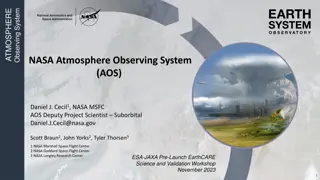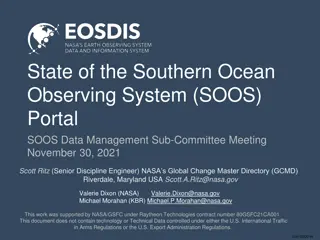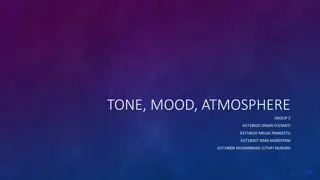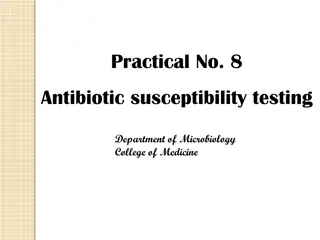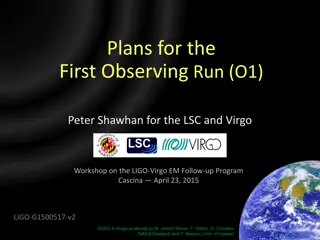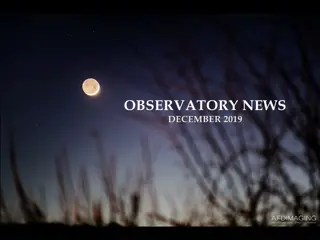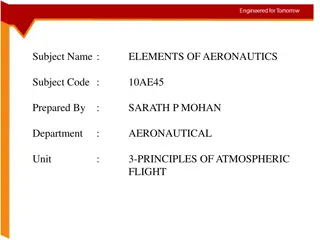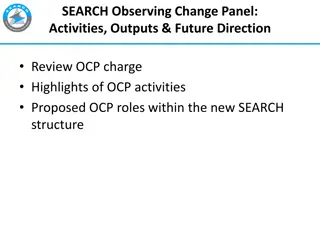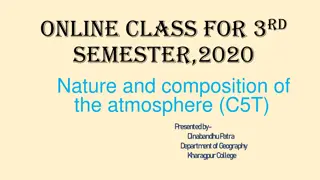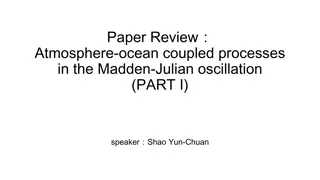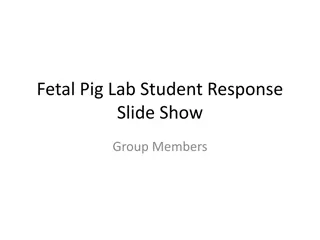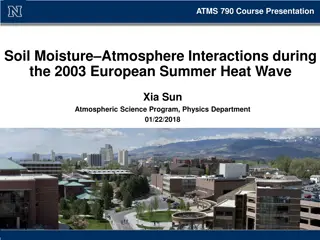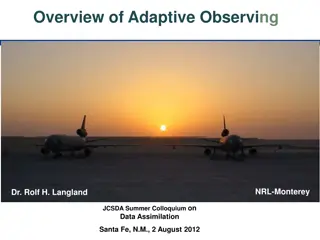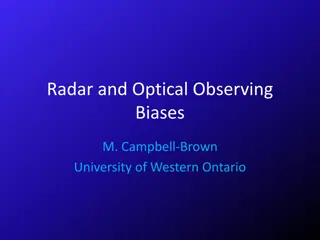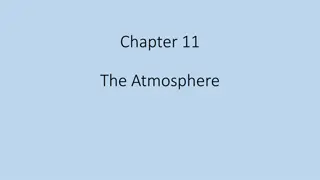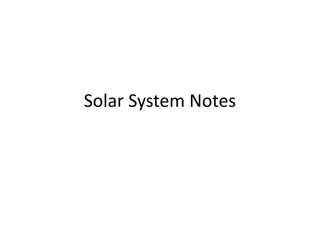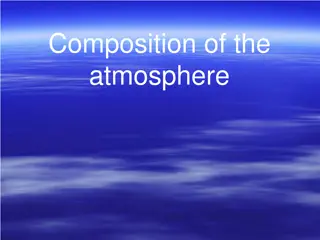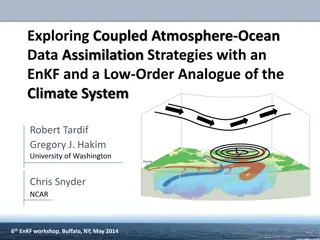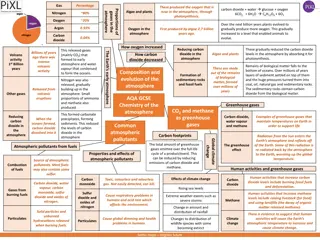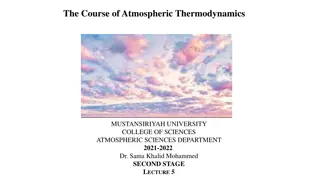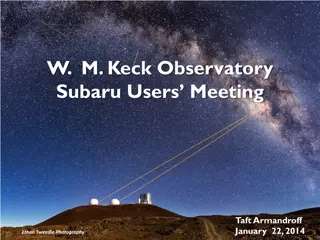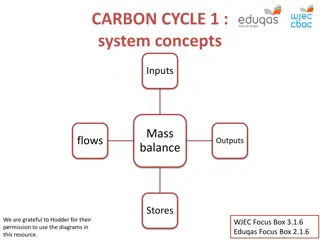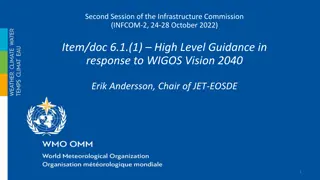[PDF⚡READ❤ONLINE] Solar Surveyors: Observing the Sun from Space (Springer Praxis
\"COPY LINK HERE ; https:\/\/getpdf.readbooks.link\/B0B83VV524\n\n[PDF READ ONLINE] Solar Surveyors: Observing the Sun from Space (Springer Praxis Books) | Solar Surveyors: Observing the Sun from Space (Springer Praxis Books)\n\"\n
0 views • 6 slides
Global Climate Models
Scientists simulate the climate system and project future scenarios by observing, measuring, and applying knowledge to computer models. These models represent Earth's surface and atmosphere using mathematical equations, which are converted to computer code. Supercomputers solve these equations to pr
3 views • 15 slides
Initial Composition and Requirements of GBON for Effective Meteorological Monitoring
The 19th World Meteorological Congress established the Global Basic Observing Network (GBON) to enhance meteorological monitoring worldwide. The GBON includes specific resolutions, guidelines, requirements, and compliance criteria for surface land stations, upper air stations, aircraft data, and rem
3 views • 24 slides
The Role of Sunlight, Ozone, and Plant Life in Earth's Atmosphere
Sunlight plays a crucial role in the formation of ozone from oxygen, leading to the protection of plant life against harmful UV radiation. The ozone produced by sunlight helps in the photosynthesis process of plants, which in turn release oxygen, absorb CO2, and contribute to the overall balance of
7 views • 23 slides
NASA Atmosphere Observing System (AOS) Overview
NASA's Atmosphere Observing System (AOS) comprises innovative technologies and instruments to study aerosol, cloud, convection, and precipitation processes. AOS includes the AOS-Storm and AOS-Sky missions, utilizing various sensors like radars, lidars, radiometers, and polarimeters to address key at
1 views • 13 slides
Understanding Atmosphere Composition and Structure in Climatology
The study of climatology, focusing on the atmosphere, is presented by Dr. Banashree Saikia, covering topics such as atmospheric composition, insolation, temperature variations, atmospheric pressure, wind systems, atmospheric moisture, climatic classification, cyclones, and monsoons. The atmosphere,
1 views • 9 slides
Insights on State of the Southern Ocean Observing System (SOOS) Portal Data Management
Delve into the recent discussions and updates from the Southern Ocean Observing System (SOOS) Portal Data Management Sub-Committee Meeting attended by Scott Ritz, Valerie Dixon, and Michael Morahan. Explore the challenges related to metadata documents, portal usage, and GCMD keyword status as highli
0 views • 13 slides
Eerie Atmosphere: Unveiling Mysterious Settings
Dive into the world of creating atmosphere and tension in writing by exploring the use of descriptive language, figurative expressions, and sensory details. Learn how to craft a mysterious and spooky atmosphere in a story through vivid descriptions and emotive vocabulary, as exemplified in a deserte
0 views • 6 slides
Observing Local Government Elections: Roles, Responsibilities, and Accreditation
Learn about the crucial roles and responsibilities of election observers in promoting free and fair elections, including observing voting processes, counting votes, and ensuring transparency. Understand the accreditation process, identification requirements, and the importance of election observatio
1 views • 30 slides
Understanding Tone, Mood, and Atmosphere in Literature
Atmosphere, mood, and tone are essential elements in literature that shape the emotional tone of a literary work, influence reader expectations, and convey the author's attitude. They are interconnected yet distinct aspects that add depth and complexity to storytelling. This analysis delves into the
0 views • 12 slides
Demonstration of Salivary Amylase Enzyme Action in B.Sc. Practical
Salivary amylase, an enzyme found in saliva, partially hydrolyzes starch into maltose. This practical involves observing the action of salivary amylase on starch, demonstrating how starch is broken down into glucose and maltose. The procedure includes preparing solutions, collecting saliva, mixing w
0 views • 5 slides
Understanding Antibiotic Susceptibility Testing
Antibiotic susceptibility testing is crucial in determining the effectiveness of antibiotics against specific bacteria. The Kirby-Bauer method, a standardized paper disk agar diffusion method, is commonly used for this purpose. By observing zones of inhibition around antibiotic disks on agar plates,
1 views • 21 slides
Understanding Gases and Plasmas in the Atmosphere
Delve into the concepts of gases and plasmas in the atmosphere, exploring topics such as fluid pressure, buoyancy, and the unique properties of gases compared to liquids. Discover how the balance between kinetic energy and gravity determines the thickness of our atmosphere and why it is essential fo
0 views • 25 slides
Observing Run O1: The Big Picture and Event Candidate Selection
Plans for the First Observing Run (O1) in the LIGO-Virgo EM Follow-up Program involving GEO 600, LIGO Hanford, KAGRA, Virgo, LIGO Livingston, and LIGO-India. Details on data transfer, quality validation, event candidate selection, preliminary alerts, interpretation, updated information, and validati
0 views • 15 slides
Observatory News December 2019: Lunar and Dark Sky Observing Sessions Schedule
In December 2019, the observatory presents a schedule of lunar and dark sky observing sessions. The sessions include Lunar Sessions on December 6th, 7th, January 3rd, and 4th, as well as Dark Sky Sessions on December 20th, 21st, 23rd, 27th, 28th, 30th, and January 3rd. It is advised to check their w
1 views • 14 slides
Principles of Atmospheric Flight in Aeronautics
This material covers essential topics in aeronautics including the physical properties of the atmosphere, standard atmosphere relationships, Mach number theory, lift and drag principles, stability, control, pressure and temperature variations based on location and solar activity, and the Internation
0 views • 22 slides
Coupled Ocean-Atmosphere Modeling on Icosahedral Grids
Coupled ocean-atmosphere modeling on horizontally icosahedral and vertically hybrid-isentropic/isopycnic grids is a cutting-edge approach to modeling climate variability. The design goals aim to achieve a global domain with no grid mismatch at the ocean-atmosphere interface, with key indicators such
1 views • 21 slides
Review of SEARCH Observing Change Panel Activities and Future Directions
The SEARCH Observing Change Panel (OCP) plays a crucial role in guiding the development of the observation component of SEARCH. The panel collaborates with various scientific communities to develop and update observation system plans, assess current components, identify gaps, and foster relationship
0 views • 19 slides
Understanding the Nature and Importance of Earth's Atmosphere
Earth's atmosphere is a vital component that supports life on our planet. It is a thin gaseous envelope surrounding Earth, providing essential elements for living beings. The composition and development of the atmosphere have evolved over billions of years. The atmosphere plays a crucial role in pro
3 views • 14 slides
Understanding Gases in the Earth's Atmosphere
Explore the composition and layers of the Earth's atmosphere, including the significance of gases like nitrogen, oxygen, water vapor, and carbon dioxide. Learn how human activities impact atmospheric composition and how changes in temperature and pressure affect weather predictions. Discover the rol
0 views • 13 slides
Understanding Atmosphere-Ocean Coupling in Madden-Julian Oscillation
Atmosphere-ocean coupled processes in the Madden-Julian Oscillation (MJO) play a crucial role in intraseasonal oscillations. This paper review by Shao Yun-Chuan explores how the ocean's Sea Surface Temperature (SST) influences surface fluxes, MJO convection, and energy balance dynamics. It delves in
0 views • 17 slides
An Ocean of Opportunity: Exploring Ocean Observing at Conference OceanObs 19
Discover the latest insights on air-sea heat flux, wind stress, and atmospheric ECVs at the OceanObs 19 conference in Hawaii. Engage with 1200 ocean observing scientists, program managers, and policy experts to chart the next decade of ocean observing and enhance international collaboration on ocean
1 views • 16 slides
Fetal Pig Dissection Lab: Observing External Features and Respiratory System
In this detailed lab report on fetal pig dissection, students are tasked with observing the external features of the pig, determining its gender, examining teeth and skin, and studying the importance of the umbilical cord. The lab also delves into the respiratory system, focusing on cartilage rings,
0 views • 24 slides
Soil Moisture-Atmosphere Interactions in the 2003 European Summer Heat Wave
This presentation discusses the significant impacts of soil moisture-atmosphere interactions during the 2003 European Summer Heat Wave, highlighting the abnormally hot weather, pavement buckling, and high-pressure systems that contributed to the extreme conditions. The images and diagrams illustrate
0 views • 27 slides
Adaptive Observing Techniques for Weather Forecasting
This presentation by Dr. Rolf H. Langland explores the concept of adaptive observing in atmospheric applications, focusing on the methodology, field programs, challenges, and objectives of targeted observing. It delves into the optimization problem of determining locations for special atmospheric ob
0 views • 47 slides
Understanding Radar and Optical Observing Biases in Meteor Detection
Exploring radar and optical observing biases in meteor detection, this content delves into factors affecting mass detection, ionization efficiency, transverse radar effects, and more. Gain insights into how radar technology plays a crucial role in determining meteor properties and overcoming observa
1 views • 13 slides
Understanding Earth's Atmosphere Composition and Layers
Earth's atmosphere is primarily composed of nitrogen and oxygen, with other gases like argon, CO2, and water vapor making up the remaining percentage. While the levels of nitrogen and oxygen remain constant, variable gases like water vapor fluctuate based on location and time. CO2 levels have been i
0 views • 53 slides
Explore Our Solar System: Planets, Moons, and More
Delve into the wonders of our solar system, from Mercury, the closest planet to the Sun, to Jupiter, the largest planet with its multitude of moons. Learn fascinating facts about each planet's unique characteristics, including their distances from the Sun, lengths of days and years, and intriguing f
0 views • 15 slides
Composition of the atmosphere
The atmosphere is a mixture of gases, with 78% nitrogen, 21% oxygen, and the remaining 1% comprising various gases like carbon dioxide, helium, argon, neon, and hydrogen. Water vapor, an essential component, influences humidity and plays a crucial role in weather patterns. Through gravity, the atmos
0 views • 7 slides
The Global Observing System for Climate and Terrestrial Climate Observations
The Global Observing System for Climate (GCOS) plays a crucial role in observing climate-related variables globally. Established in April 1992, GCOS focuses on what, how, and where to measure, sustain measurement, manage change, data transmission, management, rescue, and access. It addresses concern
0 views • 17 slides
Understanding Atmospheric Composition and Structure
The presentation covers fundamental concepts related to the Earth's atmosphere, including its composition, origin of oxygen, dry and moist layers, standard atmosphere layers, and temperature variations. Key topics discussed include the primordial atmosphere, atmospheric constituents, water vapor dis
0 views • 58 slides
Exploring Coupled Atmosphere-Ocean Data Assimilation Strategies with EnKF
This study explores data assimilation strategies for coupled atmosphere-ocean systems using an Ensemble Kalman Filter (EnKF) and a low-order analogue of the climate system. Motivated by the growing interest in near-term climate predictions, the challenges of interacting slow and fast components of t
0 views • 21 slides
Evolution of Earth's Atmosphere and the Role of Plants in Oxygen Production
Earth's atmosphere has evolved over billions of years, with plants and algae playing a crucial role in producing oxygen through photosynthesis. This process gradually increased oxygen levels, enabling the evolution of animals. The reduction of carbon dioxide levels by plants absorbing it for photosy
0 views • 4 slides
Understanding Atmospheric Thermodynamics and Environmental Lapse Rate
Explore the concepts of atmospheric thermodynamics including the Parcel Method, Environmental Lapse Rate, and Conditionally Unstable Atmosphere. Dive into the details of how air parcels behave in different atmospheric conditions and understand the significance of temperature changes in the atmospher
0 views • 27 slides
Enhancing Air Quality Forecasting with TEMPO Retrievals in Proxy Observing System
Improvements in Air Quality Forecast Skill (AQFS) are explored by assimilating TEMPO retrievals in a Proxy Air Quality Observing System (AQOS) using WRF-Chem/DART. The study focuses on benefits identified through a designed OSSE scenario, including application to the Front Range Air Pollution and Ph
0 views • 8 slides
Detailed Process of Building MFMSA_MNE Model in Back-end Programming
The process involves preparing data, building and debugging a model, writing and estimating equations, making assumptions, compiling and solving the model, adjusting the front-end, ensuring data consistency, and observing properties through an iterative process. It includes specific steps such as co
0 views • 10 slides
Keck Observatory & Subaru Users Meeting Highlights 2014
The Keck Observatory and Subaru Users Meeting in 2014 showcased the benefits of their exchange program, enhancing scientific productivity. The event highlighted the unique wide-field and spectroscopic capabilities offered by both observatories, bringing their communities closer together and contribu
0 views • 19 slides
Enhancing Your Skills as an Astronomical Observer
Elevate your observational skills by learning to explore beyond familiar objects like M13. Discover techniques for selecting, locating, and observing various celestial bodies, aided by observing lists, star atlases, and different telescope types. Understand the importance of aperture and delve into
1 views • 37 slides
Understanding the Carbon Cycle: System Concepts and Pathways
The carbon cycle involves the movement of carbon between different stores in the global system, such as the atmosphere, oceans, and biosphere. Flows, inputs, and outputs play crucial roles in this cycle, with processes like photosynthesis and respiration impacting carbon levels. Explore how mass bal
0 views • 13 slides
High-Level Guidance for Evolution of Global Observing Systems
The High-Level Guidance document provides recommendations and priority actions for the development of implementation plans related to the WIGOS Vision 2040. It focuses on addressing key observational gaps, engaging with various WMO entities, and setting out recommendations to enhance global observin
0 views • 9 slides
![[PDF⚡READ❤ONLINE] Solar Surveyors: Observing the Sun from Space (Springer Praxis](/thumb/21536/pdf-read-online-solar-surveyors-observing-the-sun-from-space-springer-praxis.jpg)



